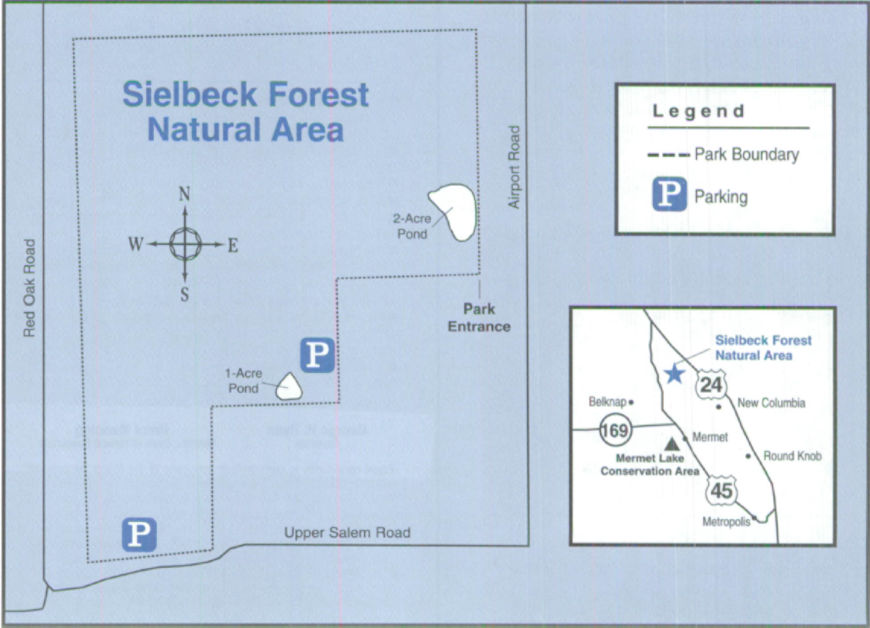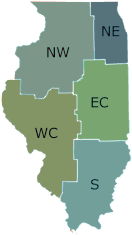Possible online services disruption due to Internet related outage
- Sielbeck Forest State Natural Area
Park Brochure
- While groups of 25 or more are welcome and encouraged to use the park's facilities, they are required to register in advance with the site office to avoid crowding or scheduling conflicts.
- At least one responsible adult must accompany each group of 15 minors.
- Pets must be kept on leashes at all times.
- Actions by nature can result in closed roads and other facilities. Please call ahead to the park office before you make your trip. We hope you enjoy your stay. Remember, take only memories, leave only footprints.
History
The answer resides in the hearts of Ruth and the now deceased Louie Sielbeck, whose family has owned and loved this tract of land for nearly 100 years. Thanks to these two, magnificent oaks and ancient cypress trees remain to provide mute testament to the natural character that once was present throughout the Big Black Slough. But while love might last forever, people do not, and soon after Louie's death this land was placed on the market. Competition for the high quality timber was intense, but others also saw value in this place for its natural character.
When bids were opened in 1997, it was The Nature Conservancy who won the day. In 1998, TNC sold the Sielbeck Forest to the Illinois Department of Natural Resources. Sielbeck Forest now is managed as a satellite of Mermet Lake State Fish & Wildlife Area. Continuing a commitment for conservation begun by Ruth and Louis Sielbeck and perpetuated by TNC, the site was enrolled in the IDNR Register of Land and Water Reserves. The Illinois Nature Preserves Commission oversees the management of land enrolled in this program. Against all odds, the natural character of Sielbeck Forest now is protected in perpetuity.
Natural Features
Visitors to Sielbeck Forest pass through bottomland hardwood forest and a forested swamp mirroring the wilderness documented by public land surveyors in 1807. This island of somber, gray timber once was part of the Big Black Slough, a wetland-rich floodplain that once covered thousands of acres in Massac, Pope and Johnson counties in southern Illinois.
Today, nearly all of this part of the Ohio River floodplain has been drained, cleared and tiled to feed a world hungry for corn, wheat and soybeans. Despite the insatiable appetite of plow, ax and saw, this tract of land remains largely undisturbed. How did this chunk of forest persist when nearly all the trees around it fell?
The Landscape
Within the 385-acre Sielbeck Land and Water Reserve occurs 110 acres of high-quality wet-mesic floodplain forest dominated by cherrybark oak, sweetgum and pin oak. Hidden within the surrounding soggy forest is 35 acres of forested swamp dominated by cypress and tupelo. Written on the faces of visitors is open-mouthed amazement at the size of the trees in this old growth remnant. Many of the trees are 200 years old and nearly 4 feet in diameter. Another common sight in ancient timber is an abundance of dead and dying trees, providing food and life for woodpeckers, cavity-nesting birds and many other wildlife species. Pileated and red-headed woodpeckers, nuthatches and tree swallows abound in Sielbeck Forest.
Another denizen of Sielbeck Forest that makes its home on the soggy forest floor is the swamp rabbit. Once common throughout the floodplain of the Ohio and Mississippi rivers, this large rabbit now is restricted to scattered tracts of floodplain forest. Although seldom seen, this critter has a curious habit of relieving itself on top of stumps and logs. A cluster of round pellets is a sure sign that a swamp rabbit is nearby.
Also found at Sielbeck Forest are the state-threatened storax, a small tree also known as American snowbell, and the state-endangered giant sedge. Both species are found only in southern Illinois, and only in high-quality floodplain forests and swamps.
Not all of the reserve is forested. The site had 212 acres of tillable ground when DNR took possession, which is being reforested to contribute to the sites natural quality and to provide additional wildlife habitat. As trees are planted, the mosaic of successional stages, coupled with the existing core of mature forest and swamp, will help to improve water quality and provide a tremendous diversity of habitat for myriad plants and animals.
Additional Information
Southern Illinois
1812 Grinnell Rd.
Belknap
62908
37.276
88.849



